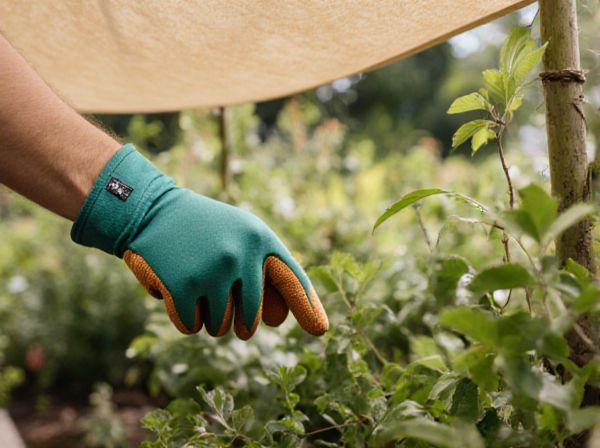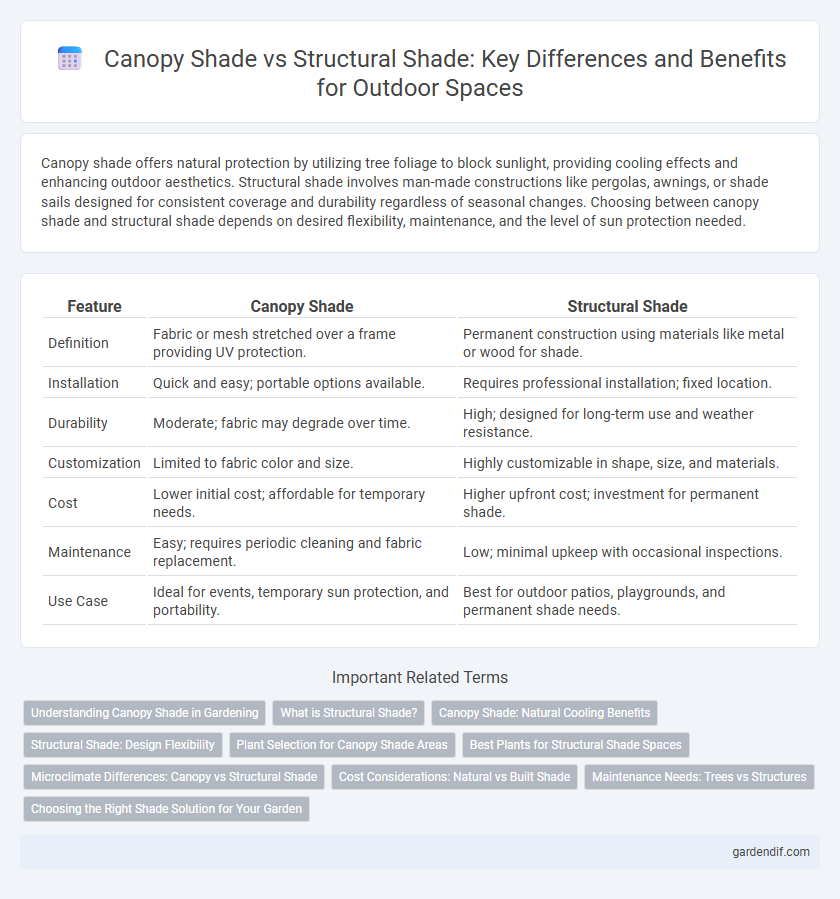
Canopy Shade vs Structural Shade Illustration
Canopy shade offers natural protection by utilizing tree foliage to block sunlight, providing cooling effects and enhancing outdoor aesthetics. Structural shade involves man-made constructions like pergolas, awnings, or shade sails designed for consistent coverage and durability regardless of seasonal changes. Choosing between canopy shade and structural shade depends on desired flexibility, maintenance, and the level of sun protection needed.
Table of Comparison
| Feature | Canopy Shade | Structural Shade |
|---|---|---|
| Definition | Fabric or mesh stretched over a frame providing UV protection. | Permanent construction using materials like metal or wood for shade. |
| Installation | Quick and easy; portable options available. | Requires professional installation; fixed location. |
| Durability | Moderate; fabric may degrade over time. | High; designed for long-term use and weather resistance. |
| Customization | Limited to fabric color and size. | Highly customizable in shape, size, and materials. |
| Cost | Lower initial cost; affordable for temporary needs. | Higher upfront cost; investment for permanent shade. |
| Maintenance | Easy; requires periodic cleaning and fabric replacement. | Low; minimal upkeep with occasional inspections. |
| Use Case | Ideal for events, temporary sun protection, and portability. | Best for outdoor patios, playgrounds, and permanent shade needs. |
Understanding Canopy Shade in Gardening
Canopy shade in gardening refers to the natural coverage provided by the leaves and branches of trees or tall plants, creating a cooler microclimate beneath. Unlike structural shade, which relies on man-made elements like pergolas or shade sails, canopy shade contributes to biodiversity and supports the growth of shade-loving plants by filtering sunlight. Understanding canopy shade helps gardeners select appropriate plants and optimize garden design for temperature control and soil moisture retention.
What is Structural Shade?
Structural shade refers to permanent, engineered installations designed to provide consistent sun protection, often using materials like steel, aluminum, or wood. Unlike canopy shade that relies on fabric or temporary coverings, structural shade incorporates solid roofs, pergolas, or shade sails anchored firmly to withstand weather elements. These constructions enhance outdoor usability by offering durable, long-term shelter from UV rays and heat.
Canopy Shade: Natural Cooling Benefits
Canopy shade provides significant natural cooling benefits by blocking direct sunlight and reducing surface temperatures underneath. The leaves in a canopy promote evaporative cooling through transpiration, which lowers ambient air temperature effectively. Unlike structural shade, canopy shade's organic nature enhances air circulation and creates a cooler microclimate essential for outdoor comfort and energy savings.
Structural Shade: Design Flexibility
Structural shade offers superior design flexibility compared to canopy shade by allowing customized shapes, sizes, and materials tailored to specific architectural needs. It integrates seamlessly with building aesthetics while providing durable protection against sun exposure and weather elements. This adaptability makes structural shade an ideal solution for diverse environments, from residential patios to commercial outdoor spaces.
Plant Selection for Canopy Shade Areas
Plant selection for canopy shade areas should prioritize species that thrive under reduced sunlight and varying moisture conditions, such as Japanese maples, dogwoods, and hostas. These plants exhibit tolerance to dappled shade and support biodiversity by attracting pollinators like bees and butterflies. Incorporating native shade-tolerant ground covers, including ferns and wild ginger, enhances soil health and minimizes maintenance in shaded landscapes.
Best Plants for Structural Shade Spaces
Structural shade spaces benefit from shade-tolerant plants like hostas, ferns, and astilbes, which thrive under limited sunlight and create lush, green textures. Evergreen shrubs such as boxwood and holly provide year-round coverage and maintain structure in shaded conditions. Incorporating shade-loving groundcovers like pachysandra and vinca minor helps to prevent soil erosion and adds color to these typically darker environments.
Microclimate Differences: Canopy vs Structural Shade
Canopy shade creates a natural microclimate by lowering temperature through transpiration and providing variable light diffusion, enhancing local humidity and air circulation. Structural shade, such as pergolas or shade sails, offers consistent thermal protection by blocking direct sunlight but lacks the dynamic cooling effects of vegetation. These microclimate differences affect comfort levels, biodiversity, and energy savings in outdoor environments.
Cost Considerations: Natural vs Built Shade
Canopy shade, created by natural tree coverage, generally incurs lower initial costs compared to structural shade due to the absence of construction expenses. Structural shade solutions, such as pergolas or awnings, require investment in materials, labor, and ongoing maintenance but offer customizable designs and immediate shade. Evaluating long-term costs reveals that canopy shade benefits from natural growth without repair costs, whereas structural shade may involve higher financial commitments but provides reliable, consistent protection from the sun.
Maintenance Needs: Trees vs Structures
Canopy shade from trees requires regular maintenance such as pruning, watering, pest control, and leaf cleanup to ensure healthy growth and optimal coverage. Structural shade, like pergolas or awnings, demands periodic inspections for wear and tear, cleaning, and repairs to fabric or framework to maintain durability and safety. Trees offer natural cooling and aesthetic benefits but involve more ongoing care compared to the generally lower maintenance needs of built shade structures.
Choosing the Right Shade Solution for Your Garden
Canopy shade provides flexible, breathable coverage ideal for gardens needing natural airflow and light filtration, while structural shade offers permanent, sturdy protection with materials like metal or wood that enhance garden architecture. Selecting the right shade solution depends on factors such as garden size, sunlight intensity, and desired aesthetic, with canopy shade suited for seasonal use and structural shade preferred for long-term durability. Consider maintenance requirements, installation complexity, and budget to ensure the shade complements plant health and outdoor comfort effectively.
Canopy Shade vs Structural Shade Infographic

 gardendif.com
gardendif.com